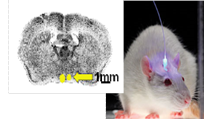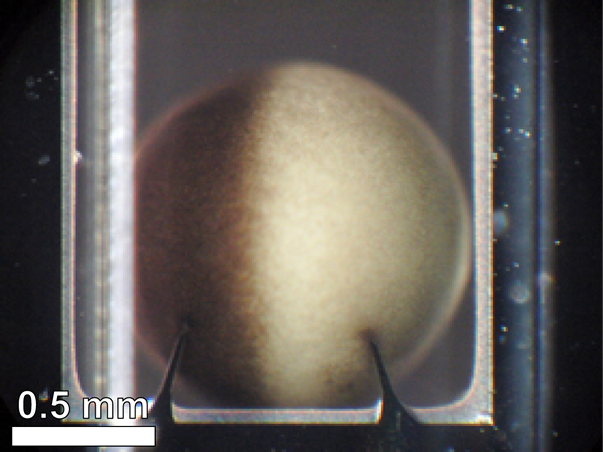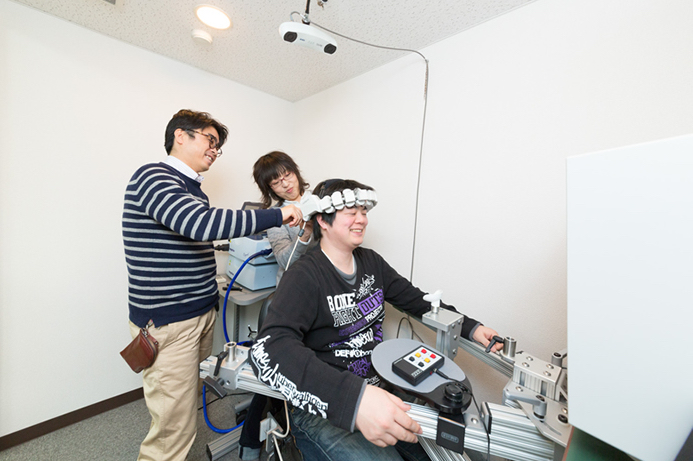Research & Education
Advanced Research Activities
This program is based on sensing, transmitting, accumulating, analyzing, modeling, and simulating techniques for wide-ranging and large-scale brain information. We propel research in the following 5 challenging fields nurturing the necessary abilities for students to pursue their studies in brain science and to develop and apply state-of-the-art information electronics that mimic the processing power of the human brain. Our final goal is to make Japan a “developed country in problem-solving technology” through fostering and developing brain-information-inspired business.
【Challenge Field 1】 Analysis of Genomic Function

Control and monitoring of
the central nervous system associated
with the circadian rhythm
Neuron networks and complex tissue structure formation are essential for information processing in the brain, such as sensory perception, cognition, memory, and learning. This type of brain structure information is stored in DNA base sequences (genomic information) and passed on from generation to generation. Toyohashi University of Technology owns and operates state-of-the-art next-generation sequencers that can analyze genomic information from living animals with high throughput. Under such favorable research conditions, we are conducting basic research using genomic level analysis of various life phenomena, including circadian rhythm mechanisms driven by clock genes (using mice), symbiotic relationships between insects and bacteria, the RNA interference process, bacterial community composition, and algal photonic synthesis. We are also active in the application of research such as for the regulation of mouse nerve cell activity, the physiochemical response of individual animals, and bacterial gene expression using “optogenetics,” a technique for controlling biological activities with an externally applied light stimulus. Other studies include new drug developments that apply RNA technology and biosensors using recombinant yeast, with industrial applications in mind. In this program, we aim to pioneer the field of brain research making good use of the latest devices and expertise for genome analysis.
【Challenge Field 2】Biosensing
Signal transmission between biological molecules, cells, or tissues is based on well-coordinated mechanical, chemical, and electrical changes. Accurate sensing of signal transmission helps in the understanding of biological mechanisms. In other words, biochemical reactions are highly selective and organized phenomena that occur in a nano or micro space. We are now trying to develop a chemical sensor device based on a biological mechanism. Our focus is on olfactory receptors as chemical sensors because chemical substances are registered by chemical receptors expressed on the cell membrane. We use olfactory receptors expressed in Xenopus leavis oocytes via a genetic modification technique. Such receptors, when combined with the target chemical substances, act on the ion channel on the cell membrane, generating a change in the cell membrane’s electric potential. We make electrodes using semiconductor manufacturing processes, and try to develop hybrid organic-inorganic electronic devices. As shown in the figure, two electrodes, one for maintaining membrane potential and the other for measuring current, are inserted into the cell to obtain a chemical substance detection signal via an amplifier. Due to the high specificity of the substrate, which is one of the characteristics of the biological reaction, minor differences between the target and other substances can be identified. As there are various types of receptors available to choose from, these sensors can apply to the detection of different chemical substances.




【Challenge Field 3】Nano-photonics

The most outstanding property of brain information is its variety and volume. To transmit, accumulate, and effectively process such quantities of data acquired through genome function analysis, bio-sensing, and other means, the corresponding information technology is essential. In particular, with the advent of functional magnetic resonance imaging (fMRI), magnetoencephalography (MEG), and other means of brain functional imaging data collection, how such vast quantities of data can be stored and managed is an urgent issue.
Our investigation into new nano-structures has produced unprecedented levels of functionality into materials and devices that enable mutual interaction among electricity, light, and magnetism. We succeeded in developing collinear holographic optical information memory and demonstrated, for the first time in the world that a CD-size holographic optical disk can store as much as a terabyte of data, which is now the world standard specification. This supergiant data-storage device gave birth to unique information technology such as high-speed optical communication lines using holographic optical switches. Another development is the super-fast spatial light modulators and three-dimensional (3-D) displays that you can wear with no need for glasses. These are particularly useful for 3-D imaging of medical data.
By combining our renowned information technology with the enormous brain information accumulated, transmitted, displayed, and analyzed in this program,we plan to develop brain information processing technology that goes far beyond all currently known approaches.
【Challenge Field 4】Brain Information Decoding


To establish human-oriented technology, we need to understand the cognition and behavior of human beings. For this purpose, establishing neural decoding techniques is an unavoidable challenge for brain science. The usual means for simultaneously recording human brain activity at multiple sites include non-invasive fMRI, MET,positron emission tomography (PET), EEG, and invasive electrocorticogram (ECoG). Estimating cognitive states from brain activities will lead to a better understanding not only of perceptual and sensory function but also emotional and subjective processing such as intelligibility, preference, comfort, and decision-making processes. This, in turn, provides a foundation for understanding and reconstructing relationships between information networks and human society, and may also help to support amyotrophic lateral sclerosis (ALS) patients to communicate their intention or recover lost senses or promote the establishment of effective means of treatment for brain diseases such as Parkinson’s disease.
Sensing devices or data storage technologies developed through the above mentioned Challenge Fields 1 to 3 will be verified for practical applications, in cooperation with Hamamatsu Medical University and the National Institute for Physiological Sciences, at the animal experiment facility that belongs to our Electronics-Inspired Interdisciplinary Research Institute. Experiments on rats, mice, and non-human primates can be conducted at this facility. Few Japanese universities have such a facility, which underscores the excellent research environment at our university for interdisciplinary research. There are also many projects on neuroinformatics and brain engineering underway at our university (e.g. The JSPS Grant-in-Aid project, “Brain and Information Science on SHITSUKAN (material perception)” the Strategic Information and Communication R&D Promotion Program of the Ministry of Affairs and Communications), which can be put to good use for meeting our designated challenges.
NIDEK, our partnership company,pushes forward research and development for artificial visual systems with unique world-class technology. Under the framework of our academic-industrial alliance, we are committed to overcoming our challenges.
【Challenge Field 5】Virtual Brain Simulation

It is expected that the amalgamation of information technology and brain science/neuroscience may reveal brain structure and function and help to create brain disease treatment methods and information technologies, as well as contributing to other fields. One of the most important techniques in this field is modeling/simulation, which seamlessly combines the vast scientific knowledge accumulated so far to understand the brain as a system, irrespective of the scale of this information.
Through the research in the above-mentioned challenge fields, it is expected that data and knowledge will be accumulated at various scales. The data will relate to a range of processes from neurotransmitter substances,nerve cell activities, fMRI, and brain waves to cognitive state and behavior. In this challenge, we aim to describe and consolidate the data as mathematical models or to reproduce or estimate the data as virtual brains through computer simulations. To this end, we are going to develop (a) data mining techniques to extract and analyze only the most substantial and useful information from the enormous volume of brain data accumulated, (b) a first-principle nanoscale analysis technique to reveal, on a molecular level, the interaction between brain disease-related genes/proteins and brain substances and their dynamic mutation processes, and (c) cerebral nerve simulation techniques to model relationships between brain function and corresponding synapse/neural circuits. We are also pushing forward with research for a virtual brain, which will hierarchically combine the above-mentioned techniques, and cognitive/social robotics that will be controlled by this kind of virtual brain.